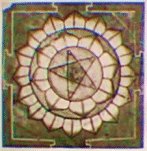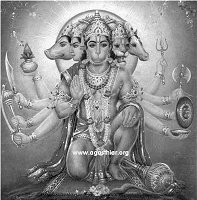SIGNIFICANCE OF NUMBER 5
booklet compiled by Lalitha Venkat for Anita Ratnam (Artistic Director, Arangham Dance Theatre)
Source: Internet
HINDUISM
* Pancha Rudra represent the five faces of Rudra (Lord
Shiva) and they are sadyojatam (West); vaamadevam (North); aghora
(South); tatpurusha (East) and eesaana (Oordvaa - looking up).
* PanchAkshara, the holy five syllables (literally holy five
letters) is the supreme mantra of devotees of Lord Shiva. As the name
suggests it is made up of five syllables. This great mantra is namaH
shivAya. The five syllables in this mantra are na - maH - shi - vA -
ya.
* The Holy Five Syllables namaH shivAya is the heart of the Vedas.
It is the core of the very famous chapter that stands in the middle of
the Vedas - the shata rudrIyam or rudra sUktam. This great mantra of
Veda Samhita while hailing the God as the Lord of everything of the
worlds, salutes the God as namaH shivAya cha shivatarAya cha.
* The Dance of Shiva - the Nataraja figure represents panchakriya,
the 5 activities of God - Srishti (overlooking, creation and
evolution), Sthithi (preservation and support), Samhara (destruction,
evolution), Tirobhava (veiling, embodiment, illusion and also giving
rest), Anugraha (release, salvation, grace). The importance of the 5
activities and the 5 elements is represented in each detail. Nataraja’s
nose symbolizes air, his face - the earth, his third eye - the fire, the
radiance of his face - the sky, the hair - water. Separately
considered, these are the activities of Brahma, Vishnu, Rudra, Maheswara
and Sadashiva.

* Kali Yantra - The encompassing circle is avidya (ignorance); the
eight petalled lotus is the eight-fold Prakriti consisting of earth,
water, fire, air, ether, manas (mind), buddhi (intellect) and ahamkara
(egoism); the five triangles are the five jnanendriyas (jnana -
knowledge; indriyas - senses), the five karmendriyas (motor organs) and
the five pranas (breathing activities); and the bindu which is pure
consciousness reflected in maya in the bija.
* Pancha Makaras: The Pancha Tattva is essential for the worship
of Sakti. The Pancha Tattvas are wine (Madya), meat (Mamsa), fish
(Matsya), sign (Mudra) and sexual union (Maithuna). All these constitute
the five elements (or the five tatva) of which the atmosphere is made.
Wine is fire; flesh is air; fish is water; cereal is earth; sexual union
is ether.
* The five-pointed star is the signet of Vishnu.
* The four arms of every Hindu Deity are the emblems of the four
preceding manifestations of our earth from its invisible state, while
its head typifies the fifth and last Kalki-Avatar, when this would be
destroyed, and the power of Budh - Wisdom (with the Hindus, of Brahma),
will be again called into requisition to manifest itself - as a Logos -
to create the future world.
* Pancha Suktham are the five prayers addressed to Lord Vishnu and
His consorts - Purusha Suktham, Narayana Suktham, Sri Suktham, Bhu
Suktham, Neela Suktham.
* According to Hindu mythology, Paanchajanya, the first
Dakshinavrutha Sankham, emerged during the churning of the Ksheerasagara
(ocean of milk) by the devas (gods) and asuras (demons). As it rose out
of the ocean, its tremendous decibel frightened the asuras who appealed
to Vishnu to save them. Lord Vishnu obliged, taking charge of the conch
shell. The primordial sound of creation, that is the Omkar or
Pranavanadham, was thereby controlled. Hence forth, it became a part of
Vishnu's five weapons.

* According to Hanumath Prakaranam in Sri Vidyarnavatantram,
Anjaneya has five faces (Pancha Mukha) and ten weapons. The five faces
are that of Hanuman, Narasimha, Adivaraha, Hayagriva, and Garuda. There
is a belief that one of the faces is that of Sri Vinayaka. He is a
great yogi (mystic) having transcended the five senses (Pancha
Indriyas).
- In Kamba Ramayanam (in Tamil), the significance of number five is
beautifully narrated as follows: The son of one of the five (son of wind
– that is Pavana Thanaya- Hanuman), crossed one of the five (water –
the ocean), through one of the five (sky), met the daughter of one of
the five (daughter of the earth – Sita Devi), burnt down Lanka by one of
the five (fire). Here five means the five elements.
- Sundara Kandam, which highlights the heroic exploits of Lord Hanuman
at Lanka is the fifth canto in the Ramayana. Therefore, it is considered
auspicious to go around His idol 5 times, 14 times, 23 times, 32 times
or with such numbers the digits of which add to five.
* Panchabhoothas are the five bhoothas referred as akasa (sky),
vayu (air), agni (fire), jala (water), and prithvi (earth). The
qualities of akasa, vayu, agni, jala, and prithvi are sound, touch,
form, taste, and smell respectively.
* Panchabhootha Stalams: Shiva is worshipped as the embodiment of the primary elements at
Kalahasthi temple - Vayu (air)
Thiruvanaikovil temple - Apa (water)
Thiruvannamalai temple - Tejas (fire)
Kanchi Ekambareswarar temple - Prithvi (earth)
Chidambaram Nataraja temple - Akas (ether)
* Panchalingams - 5 Siva temples in Karnataka -
Vaidyeshsara, Arkeshwara, Vasukishwara or Pataleshwara,
Saikateshwara or Maraleshwara and Mallikarjuna. These five Lingams are
said to represent the five faces of Shiva.
* Five Arama kshetras of Andhra Pradesh, sacred to Shiva - Draksharama, Kumararama, Ksheerarama, Bheemarama and Amararama.
* Pancha pathi (Tamil:The five abodes of God) are the five
important pilgrim centers of Ayyavazhi religion. The first pathi is
Swamithope pathi itself and is the head quarters of Ayyavazhi. The other
pathis are Muttappathi, Thamaraikulampathi, Ambalappathi and Pooppathi.
* Pancha Ishwaram: Temples, important landmarks of ancient
Ceylon. They were Thiruketheeshwaram and Muneshwaram temples in the
West, Thondeshwaram in the South, Koneshwaram in the East and
Naguleshwaram in the North.
* Pancha-Prakara is the layout of standard temple architecture.
The five (Pancha) enclosures (Prakaras) around the Sanctum.
* Panchagavya is a mixture of five products of a cow namely, cow
dung, cow’s urine, cow’s milk, curd and ghee in a regular combination.
It is now-a-days used in agriculture for crop production.
* The five fold offering (Panchopachara) - of Gandha (sandal
paste), Pushpa (flowers), Dhupa (fragrance), Deepa (lights) and Naivedya
(food) – are submission to the Lord with a request to direct our five
senses towards the good and God.
* The entire ritual of daily worship is broadly classified into five -
(1) aasana, welcoming the divinity to partake the worship; (2) sthapana,
seating and invoking life force into the deity; (3) sannidhi karana,
establishing proper communication with the deity; (4) archana, main
worship; and (5) visarjana, bidding farewell.
* Panchaamritam: It is a mixture of choice fruits namely
banana, dates, grapes, jack, mango etc. and amritam meaning nectar.
* Five is the quinary groups of the world; the five elements of
the subtle and coarse states; their primary colors; of senses; five
faces of Siva and the twice-five incarnations of Vishnu.
* The Five Books of Law: The high-priest Hilkiah is said to have
found the Book of the Law, the Hindu Puranas (Scriptures) which were
known to the Assyrians. These had for many centuries held dominion from
the Hellespont to the Indus. The learned Brahmans, says Sir William
Jones, pre-tend that five conditions are requisite to constitute a real
purana:
1. To treat of the creation of matter in general.
2. To treat of the creation or production of secondary material and spiritual beings.
3. To give a chronological abridgment of the great periods of time.
4. To give a genealogical abridgment of the principal families that reigned over the country.
5. Lastly, to give the history of some great man in particular."
|